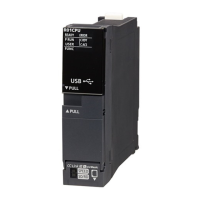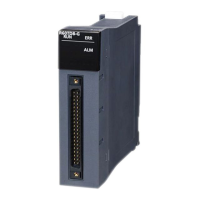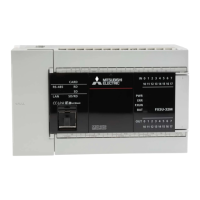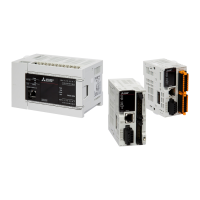892
7 APPLICATION INSTRUCTIONS
7.16 Ramp Signal Instruction
• When the execution command is on, this instruction performs processing as follows.
• The following figure shows how to change values from 0 to 350 in seven scans.
• If the change value in one scan is indivisible, correct it so that it becomes the value specified by (s2) in the number of shifts
specified by (n). For this reason, a linear ramp may not be created.
• The following figure shows the operation of processing using the RAMPQ instruction.
Program which, when X0 turns on, changes the content of D0 from 10 to 100 in six scans and holds the content of D0 when
the change is completed
• After scanning is performed the number of shifts specified by (n), the completion device specified by (d2)+0 turns on. The
on/off status of the completion device and the data in (d1)+0 are determined by on/off of the device specified by (d2)+1.
When (d2)+1 is off, the RAMPQ instruction turns off (d2)+0 in the next scan and restarts shifting from the initial value. When
(d2)+1 is on, (d2)+0 is kept on and the data in (d1)+0 remains unchanged.
• If the command turns off during execution of the RAMPQ instruction, the data in (d1)+0 will not change thereafter. When the
command turns on again, the RAMPQ instruction restarts shifting from the initial value.
• Do not change the values in (s1) and (s2) before the completion device specified by (d2)+0 turns on. The value to be stored
in (d1)+1 is calculated using the same calculation formula every scan, and therefore changing the values in (s1) and (s2)
may result in a sudden change.
• When making the digit specification using a bit device in (d1), specify it in K8Dn format.
When the digit specification is made using a bit device in (d1), it is acceptable only when the number of digits is specified in
K8.
• Shifting from the value specified by (s1) to the value specified by (s2) in the number of times specified by (n).
• For (n), specify the number of scans (number of shifts) to be performed to shift from (s1) to (s2). If the value specified in (n) is out of the range between 0 and
32768, no processing is performed.
• (d)+1 is used for the system to store the number of times the RAMPQ instruction has been executed.
• The change value per scan is calculated by the following equation.
Cv: Amount of change in 1 scan
(s2): Value specified by (s2)
(s1): Value specified by (s1)
(n): Value specified by (n)
Sc: 1 scan
50
100
150
200
250
300
350
(0)
(1)
(2)
(3)
(4)
(5)
(6)
(7)
0
Value specified by (s2) (350)
Value stored in (d1)+0 (Current value)
Number of shifts specified by (n) (7)
Value specified by (s1) (0)
Value stored in (d1)+1 (Number of executions)
X0
10
0
25
1
40
2
55
3
70
4
85
5
100
6
OFF
ON
ON
ON
D0
D1
M0 OFF
M1 OFF
X0
M0
END
M1
K6D0K100K10RAMPQ
SET
Sc Sc Sc Sc Sc Sc

